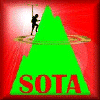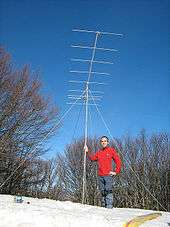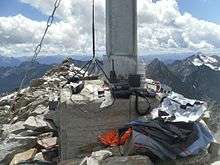Summits on the Air

Summits On The Air (SOTA) is an amateur radio operating award program launched in Great Britain in 2002, which is now known worldwide.[1] SOTA's aim is to encourage licensed amateur radio operators to operate temporarily from mountainous locations,[2] combining hiking and mountain climbing with operating their amateur radio station from the summits of hills and mountains.


Those who set up a station on a summit (usually for a few minutes to a few hours) are known as activators,[3] and those who contact ("work") activators on summits are known as chasers.[4]
Points are awarded to the activator for operating from ("activating") a summit, and to each of the chasers contacting ("working"[5]) the activator. The higher the mountain is, the more points the activator and each chaser receive.
The rules[6] include that "the method of final access to the Summit must be non-motorised" and "all equipment must be operated from a portable power source (batteries, solar cells, etc). Operation is expressly forbidden using permanently installed power sources or fossil-fuel generators of any kind". This usually forces the activators to minimize the total weight of their equipment while still bringing adequate antennas and electrical power (usually batteries) to the summits. In addition, a summit must have a minimum amount of prominence relative to the terrain surrounding it. The rules [6] state the elevation must be at least 150 meters or 492 feet. Activators must also be within the Activation Zone which is within 25 meters (83 feet) of the top of the summit.
A dedicated website, Sotawatch, shows real time information about the ongoing and planned SOTA activations ("spots" and "alerts"), and an independent project, the SOTA Mapping Project provides extensive information about the "SOTA summits" on www.sotamaps.org. All activators are encouraged to upload recorded GPS tracks if they have them. This helps others to find their way to a summit, plan estimated time of arrival, and not lose their way.
List of registered summits
As of January 2018, over 126,080 summits have been registered[7] in more than 147 associations.[8] Of those 126,080 summits, 28,335 have been activated by over 6100 activators.[7]
The official list of SOTA summits is published on "the SOTA database", and their location can be displayed on maps on www.sotamaps.org.
Awards
There are three groups of awards:[9] one for the activators, operating from the summits according to the SOTA rules,[6] one for the chasers (who contact the activators on the summits), and one for non-amateur radio operators doing shortwave listening.
The most recognized SOTA awards are "Mountain Goat"[10] for activators who reach 1,000 points, and "Shack Sloth"[11] for chasers who reach 1,000 points.[9]
The "Honour Rolls"[12][13] are published on-line for activators, chasers and Short Wave Listeners. As of December 2017, there approximately four hundred activators that have achieved "Mountain Goat" status including all associations worldwide.[13] Additionally, there are approximately sixteen hundred chasers that have reached "Shack Sloth" status.[12]
Sources of additional information
Many websites provide information about this activity, as well as videos and photos.
Several magazines for radio amateurs such as QST,[14] CQ magazine,[15] Funk Amateur,[16] PCARA,[17] RADCOM,[18] and Practical Wireless describe this activity regularly.
There are several email listservs that focus specifically on SOTA. The Yahoo Groups Page is a one place to find specific to your country or association. These lists are a means to find out about happenings, achievements, ask technical questions, and to announce upcoming activations or submit after action reports related to SOTA activities.
Many activators bring video cameras or mobile phones along to capture video to share with others on the Internet. One of the most notable activators that shoots video is Steve Galchutt,[19] known as the "Goat Hiker"[20]
Several software packages have been specially developed to facilitate the participation of amateur radio operators in this program, in particular for the preparation of expeditions to the summits, on-site navigation, logs, information for other amateurs, etc.
Additional tools
The Extras page features two additional tools for use by radio amateurs:
CSV File generator
This features an ADIF[21] to CSV converter – this accepts input in one of three forms:
- an ADIF[22] (Amateur Data Interchange Format) file;
- a CSV file for editing;
- manual entry of SOTA activities.
CSV files created can subsequently be exported for import into the SOTA database.[23]
Linked dipole designer
The linked dipole designer[24] allows the user to design a linked dipole antenna for portable/SOTA use and features a graphical display of results. The antenna can be designed for up to five different amateur bands; full details of the antenna can be exported to a PDF format file, which can then be used to build the antenna.
References
- ↑ "About SOTA". www.sota.org.uk.
- ↑ "Summits on the Air". www.sota.org.uk.
- ↑ "Activating by John, G4YSS". www.sota.org.uk.
- ↑ "Chasing by Roy, G4SSH". www.sota.org.uk.
- ↑ "Ham Radio Jargon, Abbreviations and Terminology". www.ac6v.com.
- 1 2 3 "General Rules". www.sota.org.uk.
- 1 2 "SOTA Statistics". www.sotadata.org.uk.
- ↑ "Associations". www.sota.org.uk.
- 1 2 "Awards". www.sota.org.uk.
- ↑ "Product Detail - SOTA Awards". sota-shop.co.uk.
- ↑ "Product Detail - SOTA Awards". sota-shop.co.uk.
- 1 2 "Chaser Results". www.sotadata.org.uk.
- 1 2 "Activator Scores". www.sotadata.org.uk.
- ↑ Beaufait, Mark (2015). "Turtelhead Peak On The Air" (PDF). QST. May 2015: 71.
- ↑ Kimmerly, Adam (2015). "SUMMITS ON THE AIR (SOTA)". CQ Magazine. March 2015: 10.
- ↑ "Was bedeutet SOTA?". Funk Amateur. April 2016. Archived from the original on 2016-03-30.
- ↑ Zuk, Karl (2010). "Adventures in DXing" (PDF). PCARA. April 2010: 2.
- ↑ "SOTA cover story". RADCOM. February 2015: 14. 2015.
- ↑ "WG0AT Callsign Page". QRZ Callsign Database.
- ↑ "Steve wGØAT". YouTube.
- ↑ "Amateur Data Interchange Format". adif.org. Retrieved 2016-03-08.
- ↑ "ADIF". www.arrl.org.
- ↑ "SOTA Results and Summits Database". www.sotadata.org.uk.
- ↑ "Linked Dipole Designer". SOTA Reflector.
External links
| Wikimedia Commons has media related to SOTA. |